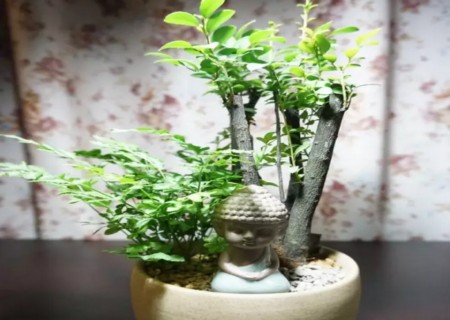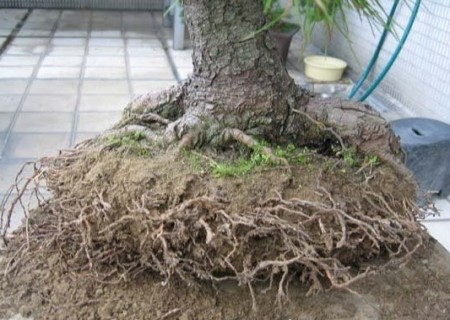What about the leaves of lobular red sandalwood bonsai?
Today, I met a friend who said that the leafy red sandalwood potted teacher who bought home lost his leaves, which was very sparse and ugly, and the leaves were almost finished. Although I couldn't find the reason after many checks, I had to ask the master of the garden for advice. After the master of the garden examined the growth of the potted plant and the soil environment in the basin, he concluded that this was due to the situation of the potted soil. So, as the landscape master said, is there something wrong with the basin soil? So, let's check it out.

First of all, open the basin soil, according to the dry and wet condition of the basin soil, we carry on the next step analysis. We know from the master that although it is normal for the master to water every half a month, it is obvious that the watering is not thorough enough, and the soil in the lower part of the basin is still dry, which naturally leads to the normal growth of lobular red sandalwood in this state of lack of water. Over a long period of time, the plant will have a large number of fallen leaves due to the lack of water supply for a long time.
Fortunately, the owner found it in time, the plant is not irreparable, we can also save it from the state of falling leaves. As long as we replenish water for it in time, especially the soil in the lower part of the basin must remain moist, that is, we must water thoroughly.
This time the owner encountered the phenomenon that the leaves of lobular red sandalwood appeared due to improper watering, so what other reasons will lead to the loss of leaves of lobular red sandalwood? In fact, there are many reasons for the loss of leaves in lobular red sandalwood. It is mainly shown in several aspects:
1. Soil consolidation
If the soil of the lobular red sandalwood bonsai hardens after a long time, the soil permeability will become very poor, then even a large amount of water will permeate the whole basin. The plant will lose its leaves because the lower root system can not get the water part.
Therefore, in view of this situation, we should loosen the soil for the plant in time, or directly replace it with loose, breathable and well-drained culture soil, which is more conducive to plant growth and can effectively avoid the phenomenon of falling leaves.
2. Lack of light
Because lobular red sandalwood is a kind of sun-loving plant, it has higher requirements for light. If the plant is in a shady growth environment for a long time, the plant will not be able to carry out normal photosynthesis to maintain and promote its own growth due to lack of light. In that case, the phenomenon of yellow leaves and falling leaves will appear over a long period of time.
If the yellow leaves and fallen leaves caused by lack of light, we only need to put the potted plants in a place where they can fully receive the light for maintenance and management. Because potted leaflet red sandalwood Xiyang needs sufficient light environment, only by providing it with enough sunlight can it grow normally without the phenomenon of yellow leaves falling.
3. Overwatering
Improper watering is another common cause of yellow leaves and fallen leaves in small-leaf red sandalwood pots. If overwatered, the soil in the basin will naturally be too moist, and if the drainage effect of the soil and flowerpot is poor, it is more likely to have stagnant water in the basin. If the root system of lobular red sandalwood is flooded for a long time, then the root system will not be able to breathe normally and hinder the absorption capacity of the root system. Plants will also lose their yellow leaves because they are unable to get nutrients and water supply.
Therefore, we should grasp the standard of watering in the process of maintenance and management. It is suggested that the basin soil should be watered only after it has become dry. If it is not watered, it will be wet, and if it is not watered, it will be watered thoroughly, so that the basin soil can always maintain the wet state needed by the plant.
4. Lack of nutrients
Lobular red sandalwood bonsai rarely leads to yellow leaves and leaf loss due to lack of nutrients. Because the lobular red sandalwood has a strong ability to adapt to the soil environment, and the requirement for basin soil is not high. However, if the basin soil itself is very poor and the only nutrients in the later stage of the soil have not been replenished in time, the phenomenon of yellow leaves and fallen leaves may still occur.
Under normal circumstances, potted leaflet red sandalwood can be irrigated with calcium magnesium phosphate fertilizer dilution solution during the growing period of seedlings or young trees, other stages generally do not need fertilization. If there is a lack of nutrients, a small amount of compound fertilizer or mineral additives can be buried in the basin soil to improve the nutrients in the soil. But do not use too much, otherwise it is easy to cause fat damage.
5. Diseases and insect pests
Diseases and insect pests are one of the causes of yellow leaves and fallen leaves in lobular red sandalwood bonsai, but we can judge whether they have been eroded by diseases and insect pests by observation. If confirmed, the corresponding drug can be used for spray disposal.
Time: 2019-05-30 Click:
- Prev

Maintenance of lobular red sandalwood bonsai
Lobular red sandalwood, recognized by the plant community as a kind of sandalwood, is very suitable for planting in the courtyard of a green tree species, at the same time its old pile is also very suitable for making bonsai. Lobular red sandalwood not only has a very high ornamental, but also has the effect of awakening the brain and calming the mind.
- Next

How to change the Pine Bonsai
Pine trees grow in the basin for too long, its roots will be circuitous and intricate distribution, the basin soil is also easy to become powdered, seriously hindering the effect of air permeability and drainage, and the decline of water conservation capacity, in this case, we need to consider as bonsai flowerpots. The change of pine pots can be carried out in spring and autumn.
Related
- Fuxing push coffee new agricultural production and marketing class: lack of small-scale processing plants
- Jujube rice field leisure farm deep ploughing Yilan for five years to create a space for organic food and play
- Nongyu Farm-A trial of organic papaya for brave women with advanced technology
- Four points for attention in the prevention and control of diseases and insect pests of edible fungi
- How to add nutrient solution to Edible Fungi
- Is there any good way to control edible fungus mites?
- Open Inoculation Technology of Edible Fungi
- Is there any clever way to use fertilizer for edible fungus in winter?
- What agents are used to kill the pathogens of edible fungi in the mushroom shed?
- Rapid drying of Edible Fungi

